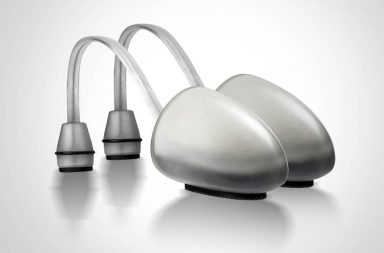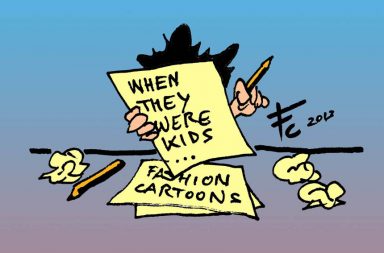The Chilean designer Marla Marchant came to the world of footwear design by chance. She started out studying industrial design, then moved on to naval architecture before finally settling on designing shoes. As she tells it, one discipline led her to the other without even realizing it.

The complexity of the ideas laid out in her Master’s project is evident so we thought it would be best to let her shed some light on it in her own words and to give us a peek at what’s really behind her work.
On the London College of Fashion website, Marla explained her work this way:
“Craftsmanship embodies the hand and mind of the people who create it. It is a testimony to the beauty and inheritance of the traditions, being one of the duties that still remain with its distinguishing trait of being passed down through familial generations.
Nowadays, the caliber of quality and details in traditional handcrafting is rarely seen. Within industrialization and mass production, craftsmanship has been less appreciated and its quality and details have deteriorated. This approach rejects the uniformity and repetitiveness of mass production, where the imperfection of the craft process is usually thought of as a failure.”
Accordingly, weaving is the main theme of this collection, where craftsmanship has been rethought. Creating a contemporary image that invites us to visit the past in order to glimpse the future has been achieved by modernizing traditional techniques and accessing the latest technologies.
The design process started by developing experimental pieces, combining traditional footwear, weaved patterns and 3d printing.
“The aesthetic enhances the weightlessness of female body, creating the illusion of hanging from a net, tying the feet down and bearing the netting into a three dimensionality. It pursues long and thin shapes while the body’s expression plays to be restricted, appearing fragile and instable from a podium that empowers it”.
Such a creative and complex mind truly deserves our undivided attention.

So Catchy!: Why did you decide to design footwear? And why this kind of footwear?
Marla Marchant: It was something that came to me naturally since it allows me to combine various abilities that I’ve acquired throughout my studies.
Since I started doing footwear, I’ve been interested in artisanal handicraft as a way of preserving traditions. After two years working with shoemakers in Chile, I decided to start the Master’s in Fashion Footwear to get more specific knowledge, but I ended up designing a conceptual collection instead.
I love experimenting in the workshop, looking for new forms, combining techniques, traditions, technology and materials. My objective is to renew and reevaluate the idea of “made by hand”.
SC!: What do you want to show with this collection? What’s your goal?
MM: Aesthetics have had a relationship with the significance of high-heeled shoes throughout history. They are linked, mainly, to the idea of power, elegance, gender, fragility or dependence (by restricting movement) according to the social and cultural context, showing both power and limitation.
This idea is emphasized by the study of Shibari, a type of Japanese bondage characterized by its beautifully precise knots.
SC!: Tells us what the project is about. It seems complex.
MM: It was an experimental process inspired by the renewal of artisanal handicraft and the desire to maintain traditions. The main, or initial part of the collection, are the fabrics. They began to take on a three-dimensional form influenced partially by Buckminster (Tensegrity) but more so by Antonio Gaudí and his method of designing the structures of the Sagrada Familia. 3D printing was later incorporated with a study of materials. It was the best method that I’d experimented with to achieve the aesthetic that I was looking for.

SC!: You’ve said that, due to the high production costs of digital technology, you have decided to finish the collection in collaboration with Eichenberger…
MM: Eichenberger is a Swiss company that works mainly with watches and jewellery and has sponsored some of the pieces in the collection. Now I’m doing them with Shapeways, with some changes in the design I was able to reduce the costs to a tenth of what they were.
SC!: What are you doing now? Finishing your project?
MM: Yes, I’m only a month from finishing the collection!
SC!: What do you want to do in the near future? Where do you see yourself in 2 years? And in 15?
MM: I’d like to keep researching and experimenting with the use of 3D printers.

SC!: Your favorite footwear designer is…
MM: Ferragamo, I find the relation between the materials and the innovation inspiring.
SC!: Where do you find inspiration for what you do? Who do you admire?
MM: It could be anything, although my favorite topics are structures and geometry, but I also like to observe people and I try to sleep with a notebook or paper nearby.
SC!: What are you doing now for work?
MM: I’m still looking.

SC!: What is a dream of yours, something that you see as unobtainable?
MM: I don’t think I want anything that is unobtainable.
SC!: What do you see as the future of footwear design?
MM: I think that 3D printing is a good alternative for making products to measure or to order, and it respects the principle of responsible production in the sense that it doesn’t generate large quantities of throwaway or unsellable products. I have to admit that I don’t think the way shoes are made is going to change. In my experience, 3D printing is expensive, which is why I’ve stopped working with my collection. They don’t come out perfectly finished either, so my pieces require two days of hand polishing, and the manufacturing time is long, it takes two days to print one pair of my shoes. Which really makes it perfect for producing luxury items!
The conceptual collection produced for her MA thesis project will be show in the 3D PrintShow in November in London and Paris.
Translated by: Michael Padilla




